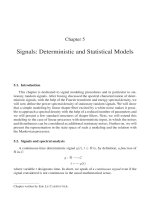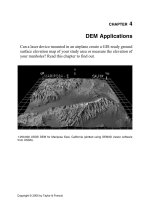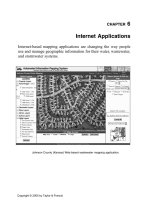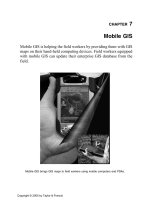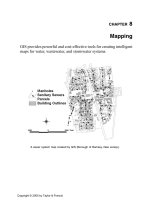GIS Applications for Water, Wastewater, and Stormwater Systems - Chapter 5 pptx
Bạn đang xem bản rút gọn của tài liệu. Xem và tải ngay bản đầy đủ của tài liệu tại đây (4.7 MB, 12 trang )
CHAPTER
5
GPS Applications
GPS technology is no longer limited to determining coordinates. It
has become an efficient and increasingly popular way for collecting
GIS attribute data for water and wastewater infrastructure.
GIS data collection for sewer system manholes using GPS.
2097_C005.fm Page 107 Monday, December 6, 2004 6:01 PM
Copyright © 2005 by Taylor & Francis
LEARNING OBJECTIVE
The learning objective of this chapter is to discover the applications of global
positioning system (GPS) technology in water industry GIS projects.
MAJOR TOPICS
• GPS basics
• GPS applications in water industry
• GPS applications in GIS
• GPS survey steps
• GPS equipment
• GPS software
LIST OF CHAPTER ACRONYMS
DGPS
Differential Global Positioning System
GPS
Global Positioning System
GLONASS
Global Navigation Satellite System (Russian System)
NAVSTAR
Navigation System by Timing and Ranging
PDOP
Positional Dilution of Precision
RTK
Real Time Kinematic
SA
Selective Availability
WGS84
World Geodetic System of 1984
STREAM MAPPING IN IOWA
In 2000, GIS and GPS were used together to map a 12-km portion of Walnut
Creek located near Prairie City in Jesper County, Iowa (Schilling and Wolter, 2000).
The objective of the mapping project was to locate channel features and identify
spatial trends among alluvial system variables that could be used to identify and
prioritize portions of the stream channel and watershed in need of further investigation
or restoration. Using Trimble Pathfinder Pro XR GPS equipment, discrete locations
(channel cross sections, debris dams, tile lines, tributary creeks, and cattle access
points) were mapped to an accuracy of 1 m, whereas the continuous data (bank
erosion rates, streambed materials, and thickness) were recorded to an accuracy of
Application Stream traversing and mapping channel features using GPS
GPS software Trimble’s Pathfinder Office
GPS equipment Trimble Pathfinder Pro XR
GPS accuracy 1 m for discrete data and 5 m for continuous data
GPS data Streambank conditions, bottom sediment material and
thickness, channel cross sections, debris dams, tile lines,
tributary creeks, and cattle access points
Study area Neal Smith National Wildlife Refuge, Jesper County, Iowa
Organization Iowa Department of Natural Resources
2097_C005.fm Page 108 Monday, December 6, 2004 6:01 PM
Copyright © 2005 by Taylor & Francis
5 m. To record continuous conditions, the GPS equipment was operated in continuous
line mode with location recorded every 5 sec. GPS data were exported into a GIS
format (ESRI Shapefile), using Pathfinder Office software. Field descriptions of the
continuous line segments and discrete features were added to the GPS location
information to create various GIS layers. Segment lengths varied from 10 to 50 m.
Discrete channel features were located by pausing the continuous line mode of the
GPS and taking points at feature locations. Stream survey data were used to model
watershed conditions, identify water sampling points, and evaluate and select appro-
priate channel-rehabilitation measures.
This chapter is intended for professionals in the geographic “positioning” field.
It presents applications of GIS and GPS for water industry infrastructure manage-
ment. The use of GPS in collecting attributes data is discussed, and methods of data
attribution are described. A review of GPS equipment and software is presented.
GPS accuracy issues are also discussed.
GPS BASICS
GPS, also referred to as Navigation System by Timing and Ranging (NAVSTAR),
is a satellite-based radio navigation system developed and operated by the U.S.
Department of Defense. The Russian government operates a similar system called
Global Navigation Satellite System (GLONASS). At the present time, GPS includes
29 active satellites located in 6 orbital planes.
GPS systems utilize a constellation of satellites orbiting the earth twice daily
(i.e., passing over approximately the same world location every 12 hours) and
transmitting precise time and position signals. GPS receivers read signals from
orbiting satellites to calculate the exact spot of the receiver on Earth as geographic
coordinates (latitude and longitude) referenced to the World Geodetic System of
1984 (WGS84) datum. The signals from at least four satellites should be available
to determine the coordinates of a position. Physical obstructions such as mountains,
trees, and buildings, and other factors such as satellite malfunction and rephasing
operations can restrict GPS signals and degrade GPS accuracy. Ideal GPS operating
conditions that provide the best accuracy are listed below (Lyman, 2001):
• Low positional dilution of precision (PDOP), a measure of best geometrical
configuration of satellites
• Good signal strength
• Little or no multipath (reflection of GPS signals off distant reflective environment
such as mountains and buildings)
• Little or no signal degradation because of geomagnetic storms and ionospheric
or atmospheric effects
The accuracy of GPS coordinates can be increased by applying differential
corrections. Differential corrections move user points closer to their “actual” loca-
tion. This is done by comparing the user’s new data on unknown locations with the
data collected at the same time on a point with known coordinate values (Zimmer,
2001b). The GPS receivers that can receive and apply the corrections in real time
2097_C005.fm Page 109 Monday, December 6, 2004 6:01 PM
Copyright © 2005 by Taylor & Francis
are called real time kinematic (RTK) receivers. Non-RTK receivers require postpro-
cessing of raw GPS data in the office. In the U.S., federal and state agencies are
cooperating to make differential GPS readily available to all users.
GPS precision can vary from a few millimeters to hundreds of meters. The required
precision depends on the project-specific requirements. The available precision varies
with GPS mode (static, RTK, or kinematic), GPS equipment, time of occupation, and
location (vegetation, reflection, and buildings). GPS survey cost increases with the
accuracy requirements. The typical utility precision standard is 3 to 5 cm.
To prevent misuse by hostile forces, the U.S. Department of Defense had intro-
duced an intentional error called the Selective Availability (SA) error in their GPS
signals. The recent advances in GPS technology had reduced the effectiveness of
the SA error. On midnight May 2, 2000, the SA error was removed 6 years ahead
of schedule by a presidential order. This event marked an important day in the history
of GPS because it increased the GPS accuracy up to ten times. The SA removal has
improved the accuracy of inexpensive GPS receivers. SA removal has also increased
the accuracy of GPS receivers operating in an autonomous (unassisted) mode without
a base station. No significant impact has been noted in the performance of survey
grade receivers (Murphy, 2001).
GPS technology is making major progress in improving the speed, reliability, and
accuracy of the mathematical processes by which coordinates are calculated from the
satellite beams (ASCE, 2001).
GPS APPLICATIONS IN THE WATER INDUSTRY
At the present time, the GPS revolution is well under way. For example, a
Mercedes-Benz driver equipped with TeleAid system can press an SOS button to
summon a tow truck, police, or ambulance. This button uses GPS technology to
transmit the specific location, model, and color of the vehicle. The GPS applications
for the water, wastewater, and stormwater systems, though not as dramatic as
TeleAid, are revolutionizing the way these systems are designed, constructed, oper-
ated, and maintained. Representative GPS applications for the management of water,
wastewater, and stormwater systems are:
1. GPS can be used to increase the accuracy of existing system maps by verifying
and correcting locations of the system components. Frequent field changes often
mean utility lines can be several feet off horizontally and/or vertically from where
they appear on the plans. Thus, unless updated frequently, most utility plans,
especially in growing cities, are outdated frequently. GPS data collection is no
longer limited to collecting coordinates of point features. Now users can bike
along a channel to map line features, or walk around a detention pond to map
polygon features.
2. New water system or sewer system maps can be created if they do not exist.
3. Water system or sewer system attributes can be collected for populating the GIS
database.
2097_C005.fm Page 110 Monday, December 6, 2004 6:01 PM
Copyright © 2005 by Taylor & Francis
Surveying
Traditionally, people have used geodetic surveying to locate and map utility
infrastructure components. Such transit survey required traversing between a known
point to the point of interest, which often took several hours per point. GPS has
been found to be up to 50% faster than the traditional methods (Anderson, 1998).
GPS survey takes only a few minutes or seconds per point. For example, up to
300 points can be surveyed in 1 day, using a GPS survey. A two-man crew with
bicycle-mounted equipment can survey up to 500 points per day.
The familiar total station is still the backbone of engineering survey work.
Although GPS is not a replacement for optical surveying, interoperability between
optical equipment and GPS is growing, and GPS is gaining ground slowly among
engineers. GPS is an ideal addition to the surveying toolbox for a variety of appli-
cations, such as locating the starting point for a new stakeout. The conventional total
station survey will require traversing a large distance for this work. GPS can do this
work much faster by navigating a person right to the point where the stake should
be placed (ASCE, 2001).
Fleet Management
An efficient fleet management system is essential to improving customer service.
A wireless system that uses GIS and GPS technologies can substantially and eco-
nomically improve the efficiency of fleet management. An integrated GIS/GPS
procedure can be used to track multiple moving vehicles from a command center.
It can show the location, speed, and movement of each vehicle on the tracking
display. Off-the-shelf mobile devices such as Web-enabled cell phones and personal
digital assistants (PDAs) can be used in conjunction with a GIS/GPS to provide the
information needed for fleet management, such as dispatching and tracking the
maintenance vehicles, generating driving directions, and trip routing. For example,
Gearworks customized MapInfo’s MapMarker J Server and Routing J Server to
calculate driving directions and travel statistics. A client-side custom mapping appli-
cation was created, which communicates with a MapXtreme server to create the
data requested by the dispatcher and to deliver the information to the drivers mobile
device. This application allows the dispatcher to view a map of the entire fleet to
better assign work orders and deliveries, perform real time tracking, and deliver
accurate status updates through the Web interface (GEOWorld, 2001).
GIS/GPS applications have consistently lowered the cost of fleet management by 10
to 15%.
GPS APPLICATIONS IN GIS
GPS technology represents a space-age revolution in GIS data collection. It is
providing an efficient and increasingly popular way for collecting both the location
(coordinates) and the attributes data in the field. The new line of GPS receivers brings
2097_C005.fm Page 111 Monday, December 6, 2004 6:01 PM
Copyright © 2005 by Taylor & Francis
technology to water- and wastewater system operators and managers, who can pop-
ulate their existing maps with precise location of features such as manhole covers,
catch basins, overflow points, hydrants, valves, pumps, flow meters, and rain gauges.
The most basic application of GPS is collection of (x,y) coordinates for the GIS
features. Initially, these coordinates were manually entered into the GIS database.
Most GPS receivers record their data in an American Standard Code for International
Interchange (ASCII) format that can be imported into a GIS without having to type
the coordinates’ values. Recent GPS equipment can provide data in a GIS-compatible
format, such as the ESRI Shapefile format.
Attributes are usually collected in two phases:
1. Initial attribution phase (Phase I) or first pass: Limited attributes can be collected
by the GPS survey crew when a structure is visited or surveyed for the first time.
These attributes — such as manhole cover type, catch basin condition (clean, debris,
etc.), or outfall condition (submerged, flowing, dry, etc.) — should be visible from
outside and should not require confined space entry or opening of structures. This
phase may also include ID-marking of structures for the second phase or future
visits. In this phase, typically 250 to 300 points can be surveyed per day.
2. Final attribution phase (Phase II) or second pass: Additional attributes can be
collected when a structure is revisited by the attribute crew. These attributes may
require field measurements, detailed inspections, confined space entry, or opening
of structures. Examples include manhole depth, pipe size, and structural or hydrau-
lic deficiencies. The final attributes depend on the mapping application. For exam-
ple, if the maps will be used to develop an H&H model, weir height in an overflow
structure might be measured. If the GIS will be used for NPDES permit reporting,
the condition of the sanitary outlet (clean, clogged, surcharged, etc.) in the overflow
structure might be a critical attribute. In this phase, final attributes for 50 to 75
structures can be surveyed per day. New real time differential GPS (DGPS) receiv-
ers can navigate the attribute crew back to the structures visited in Phase 1.
GPS SURVEY STEPS
The data conversion process for municipal utilities often begins with GPS data.
Features such as manholes and hydrants are collected using a GPS unit. These point
features are combined into a GIS layer and then attributed. At the conclusion of
each day, GPS corrections are applied if necessary. The data set is massaged to
ensure its stability including calculating the IDs and building the data set. The data
set is then exported and saved as a backup file. After the process is completed for
an entire area, check plots are created. These check plots show the lines and points
along with their attributes. The flow direction of the lines is also displayed to ensure
that proper connectivity has been established for the system. The plots are then
delivered to the municipal engineer for review.
Generally, the following steps are required to collect GIS data, using GPS
(Zimmer, 2001b):
1. Prepare a project plan to define the scope, resource inventory (paper maps, data-
bases, etc.), and data dictionary. The data dictionary is a template for field data
2097_C005.fm Page 112 Monday, December 6, 2004 6:01 PM
Copyright © 2005 by Taylor & Francis
collection. It specifies the features to be surveyed and their attributes. A simple
data dictionary for Phase-1 GPS survey of a sewer system is given below:
• Sanitary features
• San_mh
• Lid_size
• Lid_type
• Condition
•ID
• Storm features
• Catchbasin
• Size
• Type
• Condition
•ID
• Endwall
• Condition
•ID
2. Conduct field work.
3. Download data from GPS receiver to computer.
4. Perform quality assurance/quality control (QA/QC) for completeness and attribute
information.
5. Apply differential corrections if not using RTK equipment.
6. Calculate the spatial error.
7. Export GPS data and attributes to GIS.
8. Create a metadata file to document GPS survey information, such as survey date,
equipment used, horizontal and vertical accuracy, etc.
GPS EQUIPMENT
GPS equipment selection depends on the purpose or application of GPS data.
For example, for utility mapping projects, mapping-grade GPS equipment equipped
with code-based receivers is suitable. For engineering design and projects that require
highly accurate survey data, survey grade GPS equipment equipped with carrier-
phase receivers is needed. Table 5.1 provides a summary of GPS receiver types.
Accuracy specifications are based on the ideal operating conditions described earlier.
Recreational GPS Equipment
These types of receivers are intended to support recreational activities such as
hiking and camping. Commonly referred to as the “
$200 receivers
,” they provide
Table 5.1
GPS Receivers
Receiver Type Horizontal Accuracy (m) Price (US$)
Recreation 5–10 100–300
Basic 1–5 3,000–5,000
Advance <1 8,000–10,000
Survey and geodetic <0.2 25,000 and upward
2097_C005.fm Page 113 Monday, December 6, 2004 6:01 PM
Copyright © 2005 by Taylor & Francis
low accuracy and are, therefore, not suitable for most engineering, mapping, or
surveying work. They can be used as basic navigation and reconnaissance tools.
Basic GPS Equipment
These lightweight and handheld systems are about the size of a calculator. They
are less expensive ($4000) and less accurate (1 to 5 m; least accurate in woods).
Differential corrections are applied in a postprocessing step after the collected field
data have been downloaded to a computer running a GPS-processing software
package. Because of their low accuracy, they are not suitable for utility surveys.
They are more suitable for educational use. Trimble’s Geoexplorer III handheld GIS
data collection system shown in Figure 5.1 is an example of this category. Geoexplorer
Figure 5.1
Basic GPS equipment example (Trimble Geoexplorer III).
2097_C005.fm Page 114 Monday, December 6, 2004 6:01 PM
Copyright © 2005 by Taylor & Francis
provides support for popular GIS and CAD software packages such as ArcInfo,
Intergraph, MGE, MapInfo, ERDAS, and AutoCAD. Geoexplorer provides for GIS
export of GPS data, using Trimble’s Pathfinder Office software. The steps for using
Geoexplorer III GPS data in GIS are given below:
• Install Pathfinder Office software on your PC
• Create a data dictionary, i.e., define attributes for each feature type
• Transfer data dictionary from PC to receiver
• Enter attributes during GPS survey
• After the GPS survey, transfer the location and attribute data from receiver back
to Pathfinder Office on your PC
• From Pathfinder Office, export data to your GIS in ArcView Shapefile or MapInfo
format
Advanced GPS Equipment
Advanced-grade GPS receiver types include the so-called professional, mapping-
grade, and resource-grade products. These systems are more expensive ($10,000) but
provide the submeter horizontal accuracy generally required in utility mapping. Dif-
ferential corrections, which are especially applicable for accurate navigation, can be
applied in real time if the GPS receiver is linked to a radio receiver designed to receive
broadcast corrections; Trimble’s GPS Pathfinder Pro XR/XRS GIS data collection
system is an example. In Pathfinder, attributes can be entered using Trimble’s handheld
Asset Surveyor, or a pen-based notebook or Tablet PC running Trimble’s ASPEN
software. As with Geoexplorer, GIS export is accomplished using Pathfinder Office
software. The XRS models have an integrated differential correction receiver and can
provide real time submeter accuracy. Reportedly, Pathfinder also features patented
Everest multipath rejection technology to reduce or eliminate multipath signals in
reflective environments. Figure 5.2 shows Trimble’s Pathfinder Pro XR system, which
is also referred to as the “Backpack” because it stores the system components in a
convenient backpack. Figure 5.3 shows the components stored inside the Backpack.
Leica Geosystems (Heerbrugg, Switzerland) is a surveying and geomatics com-
pany that provides systems for accurate 3D data capturing, visualization, and mod-
eling of space-related data to customers in surveying, engineering, construction,
GIS, and mapping. In the GIS community, Leica Geosystems is known for its GPS
and field data collection related equipment. ERDAS, Inc. (Atlanta, GA), is the
world’s leading provider of geographic-imaging solutions. The company’s products
and related services help organizations visualize, manipulate, analyze, measure, and
integrate geographic imagery and geospatial information into 2D and 3D environ-
ments. In July 2001, ERDAS’s geographic-imaging software company was acquired
by Leica Geosystems to form a new GIS and Mapping Division for growth in the
GIS and remote sensing markets. Congestion builds up as too many users crowd the
same radio frequencies. Leica’s new GPS equipment, Leica System 500 (GS50),
provides uninterrupted RTK data link through cell phones. Also referred to as the
GIS Receiver
, GS50 is Shapefile-compatible and boasts a new “maximum tracking
technology” that allows users to work under trees and in deep urban or natural
canyons.
2097_C005.fm Page 115 Monday, December 6, 2004 6:01 PM
Copyright © 2005 by Taylor & Francis
Mapping-grade GPS equipment vertical accuracy of
±
m is not adequate if accurate
elevation data (e.g., manhole rim elevations) are required to support specific applica-
tions, such as H&H modeling and engineering design that require precise elevation data.
SURVEY GRADE GPS EQUIPMENT
Survey grade equipment features RTK technology, which can deliver
±
1 cm
horizontal and vertical accuracy in real time, using dual frequency receivers. Due to
their high accuracy, they are expensive ($25,000). Trimble’s GPS Total Station 4800
integrated real time kinematic survey system is an example of this category. Due to
their more-than-needed accuracy and high cost, they are not essential for wastewater
system mapping applications. However, survey grade GPS can save substantial
amount of time compared with the conventional ground survey method when high
accuracy is required. For example, the RTK survey for a sewer construction project
in Fitchburg (Massachusetts) was completed in a quarter of the time that a ground
survey would have taken (Mische, 2003). Survey grade GPS equipment’s centimeter-
level vertical accuracy is adequate for collecting accurate elevation data.
Figure 5.2
Advanced GPS equipment example (Trimble Pathfinder Pro XR Backpack).
2097_C005.fm Page 116 Monday, December 6, 2004 6:01 PM
Copyright © 2005 by Taylor & Francis
USEFUL WEB SITES
CHAPTER SUMMARY
Today’s GPS equipment is like a GIS mapping device. GPS receivers are being
referred to as the GIS receivers because they can collect both the geographic data
(coordinates) and the attribute data for the water industry infrastructure. The water
system and sewer system feature attributes can be captured from a GPS survey
by using field computers, handheld computers, and field data collectors. The GPS
equipment should be selected carefully to meet both the horizontal and vertical
accuracy requirements of the utility mapping projects. The so-called $200 receivers
designed for recreation activities that cannot provide accuracy of 5 m or better
are not suitable for GPS mapping of water and sewer systems. A differential GPS
that can provide real time submeter horizontal accuracy is suitable if accurate
elevations are not necessary. Survey sgrade RTK GPS equipment that provides
centimeter-level horizontal and vertical accuracy is suitable if accurate elevations
are important.
Figure 5.3
Components of Trimble Pathfinder Pro XR Backpack.
Professional Surveyor Magazine www.profsurv.com
Trimble Navigation www.trimble.com
Leica Geosystems Software www.leica-geosystems.com
2097_C005.fm Page 117 Monday, December 6, 2004 6:01 PM
Copyright © 2005 by Taylor & Francis
CHAPTER QUESTIONS
1. What is GPS accuracy, and what factors can affect it?
2. List the typical applications of GPS technology in the water industry.
3. How are GIS and GPS related? How are they helping each other?
4. Describe the typical steps for conducting a GPS survey.
5. List the various types of GPS equipment and their suitability for different appli-
cations.
2097_C005.fm Page 118 Monday, December 6, 2004 6:01 PM
Copyright © 2005 by Taylor & Francis


